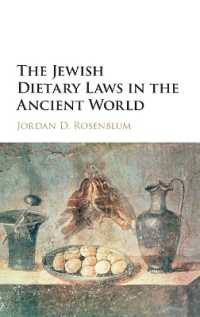- ホーム
- > 洋書
- > 英文書
- > Literary Criticism
Full Description
Amidst a culture otherwise obsessed with beauty, the Greek theater provided a unique space for Athenians to play with ugliness—to try these anti-ideals on for size. Such imaginative play was considered dangerous by some, such as Plato, who feared its corrupting influence; others, including Aristotle, saw the theater's provocation and release of emotions as educational and even therapeutic. Sophocles' and Euripides' fifth-century audiences could not help but directly confront the ugliness of their drama, but as cultural memory of embodied productions faded, an abstracted contrast emerged between beautiful tragedy and ugly comedy—a pernicious aesthetic polarization that persists to this day. A. C. Duncan's Ugly Productions embraces the materiality of the theater, arguing that dramatic aesthetics are best understood within affective frameworks where beauty or ugliness are produced through a dynamic interplay of verbal and visual modalities. Duncan reframes the Greek concept of "the ugly" not as mere "anti-beauty," but as an affective disposition positively associated with such painful emotions as pity, fear, grief, and abjection.
Through studies of the figures of Xerxes, Electra, Philoctetes, Ajax, Heracles, and other tragic figures, Ugly Productions offers detailed analyses of the various ways ugliness was produced in performance with each chapter serving as an in-depth guide for studying the aesthetics of these works. Duncan confronts the historical neglect of ugliness in critical discourses, calling for a revaluation of negative aesthetics and renewed interest in the uglier aspects of these canonical works of theater.
Contents
Introduction: Ugliness and Greek Drama
Part I: Tragedy in Tatters: Ugly Aesthetics through Costume
Chapter 1: Dressed in Dishonor: Costume, Affect, and Aesthetics in Aeschylus' Persians
Chapter 2: The Aesthetic Limits of the Costume: Beauty, Embodiment, and Performance in Euripides' Helen, Electra, and Telephus
Part II: Tragic Ugliness on The Comic Stage
Chapter 3: Ugly Tragic Materials upon The Comic Stage in Acharnians
Chapter 4: Aristophanes' Women at the Thesmophoria Festival and Theatrical Aesthetics at the Intersection of Gender and Genre
Part III: The Aesthetics of the Dramatic Corpse
Chapter 5: The Divergent Aesthetics of the Dead and Dying Bodies in Sophocles' Ajax and Women at Trachis and Euripides' Heracles
Chapter 6: The Corpse, In and Out of Frame
Epilogue: Plato, Aristotle, and the Remaking of Dramatic Aesthetics








